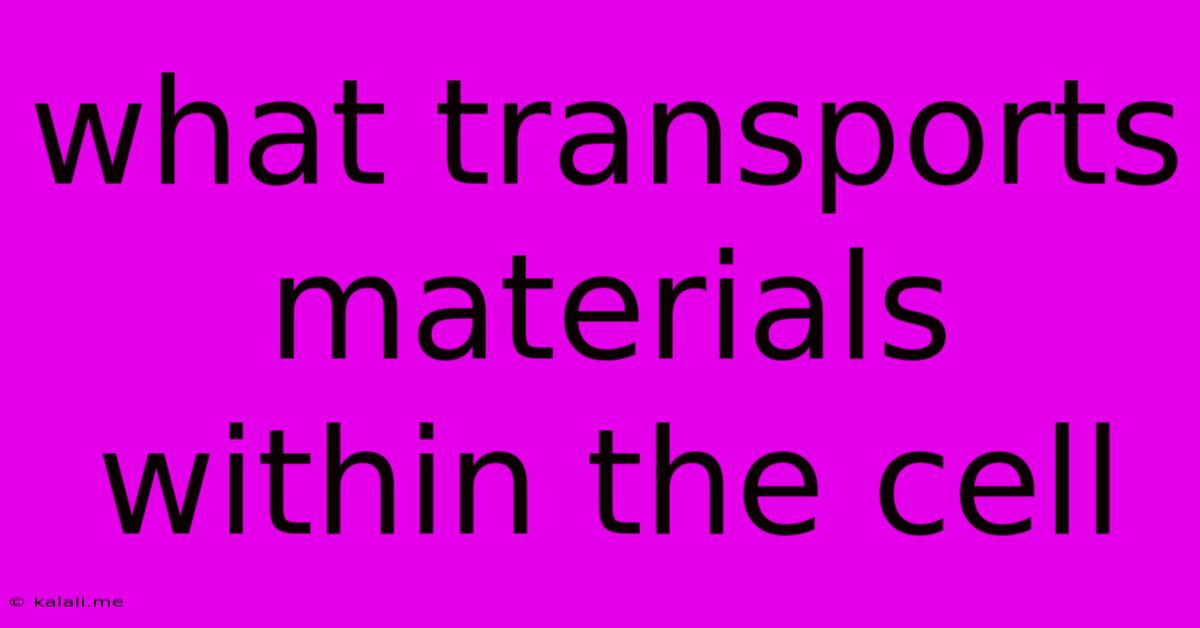What Transports Materials Within The Cell
Kalali
May 10, 2025 · 3 min read

Table of Contents
What Transports Materials Within the Cell? A Deep Dive into Cellular Transport Mechanisms
Meta Description: Discover the fascinating world of intracellular transport! This article explores the various mechanisms cells use to move materials, from simple diffusion to complex vesicle trafficking, impacting everything from cellular function to disease.
Cells are bustling hubs of activity, constantly synthesizing, modifying, and transporting a vast array of molecules. Efficient intracellular transport is crucial for maintaining cellular function, growth, and survival. But how do cells achieve this remarkable feat? The answer lies in a complex network of mechanisms, each tailored to the specific needs of the cell and the cargo being transported. This article delves into the key players in this intricate cellular ballet.
Passive Transport: The Effortless Movement
Passive transport mechanisms require no energy expenditure by the cell. They rely on the inherent properties of molecules and their environments to drive movement.
-
Diffusion: This fundamental process involves the movement of molecules from an area of high concentration to an area of low concentration, down their concentration gradient. Small, nonpolar molecules like oxygen and carbon dioxide readily diffuse across the cell membrane.
-
Facilitated Diffusion: For larger or polar molecules that can't easily cross the lipid bilayer, specialized membrane proteins provide assistance. These channel proteins and carrier proteins facilitate the movement of specific molecules down their concentration gradient, without energy consumption. Glucose transport is a prime example of facilitated diffusion.
-
Osmosis: A specific type of passive transport involving the movement of water across a selectively permeable membrane. Water moves from an area of high water concentration (low solute concentration) to an area of low water concentration (high solute concentration), aiming to equalize solute concentration on both sides of the membrane. This process is vital for maintaining cell turgor and volume.
Active Transport: Powering the Movement
Active transport mechanisms, unlike passive transport, require energy input, typically in the form of ATP (adenosine triphosphate). This energy allows the cell to move molecules against their concentration gradient, from low concentration to high concentration.
-
Protein Pumps: These membrane proteins use ATP to actively pump specific molecules across the membrane. The sodium-potassium pump, crucial for maintaining the resting membrane potential in nerve cells, is a classic example.
-
Endocytosis: This process involves the engulfment of extracellular material by the cell membrane. There are different types of endocytosis:
- Phagocytosis: "Cell eating," where large particles like bacteria are engulfed.
- Pinocytosis: "Cell drinking," where fluids and dissolved solutes are taken in.
- Receptor-mediated endocytosis: Highly specific uptake of molecules that bind to receptors on the cell surface. Cholesterol uptake is a prime example.
-
Exocytosis: The opposite of endocytosis, exocytosis involves the release of intracellular materials to the outside of the cell. This is crucial for secretion of hormones, neurotransmitters, and other cellular products.
Vesicular Transport: The Intracellular Highway System
Moving materials within the cell often involves a sophisticated system of membrane-bound vesicles. These tiny sacs transport cargo between different cellular compartments, such as the endoplasmic reticulum (ER), Golgi apparatus, and lysosomes.
-
Motor Proteins: Vesicles are transported along microtubules and microfilaments, components of the cell's cytoskeleton, by motor proteins like kinesin and dynein. These proteins utilize ATP to "walk" along these tracks, carrying their vesicular cargo to their destinations.
-
The Endomembrane System: The ER, Golgi apparatus, and lysosomes are key players in the endomembrane system, a network of interconnected organelles that work together to process and transport molecules.
The Importance of Intracellular Transport in Health and Disease
Disruptions to intracellular transport mechanisms can have severe consequences, leading to various diseases. For example, defects in protein trafficking are implicated in neurodegenerative diseases like Alzheimer's and Parkinson's. Understanding these mechanisms is therefore crucial for developing effective treatments for a range of medical conditions.
In conclusion, intracellular transport is a dynamic and multifaceted process involving a diverse array of mechanisms. From the simple diffusion of small molecules to the complex choreography of vesicular trafficking, these processes are essential for maintaining cellular function and life itself. Further research continues to uncover the intricacies of this vital cellular activity.
Latest Posts
Latest Posts
-
Probability Not A And Not B
Jun 01, 2025
-
Is It Possible To Have An Exponent Inside A Radical
Jun 01, 2025
-
Can You Add Boiled Linseed Oil To Latex Paint
Jun 01, 2025
-
What Is The Legal Drinking Age In Jamaica
Jun 01, 2025
-
Libgl Error No Matching Fbconfigs Or Visuals Found
Jun 01, 2025
Related Post
Thank you for visiting our website which covers about What Transports Materials Within The Cell . We hope the information provided has been useful to you. Feel free to contact us if you have any questions or need further assistance. See you next time and don't miss to bookmark.